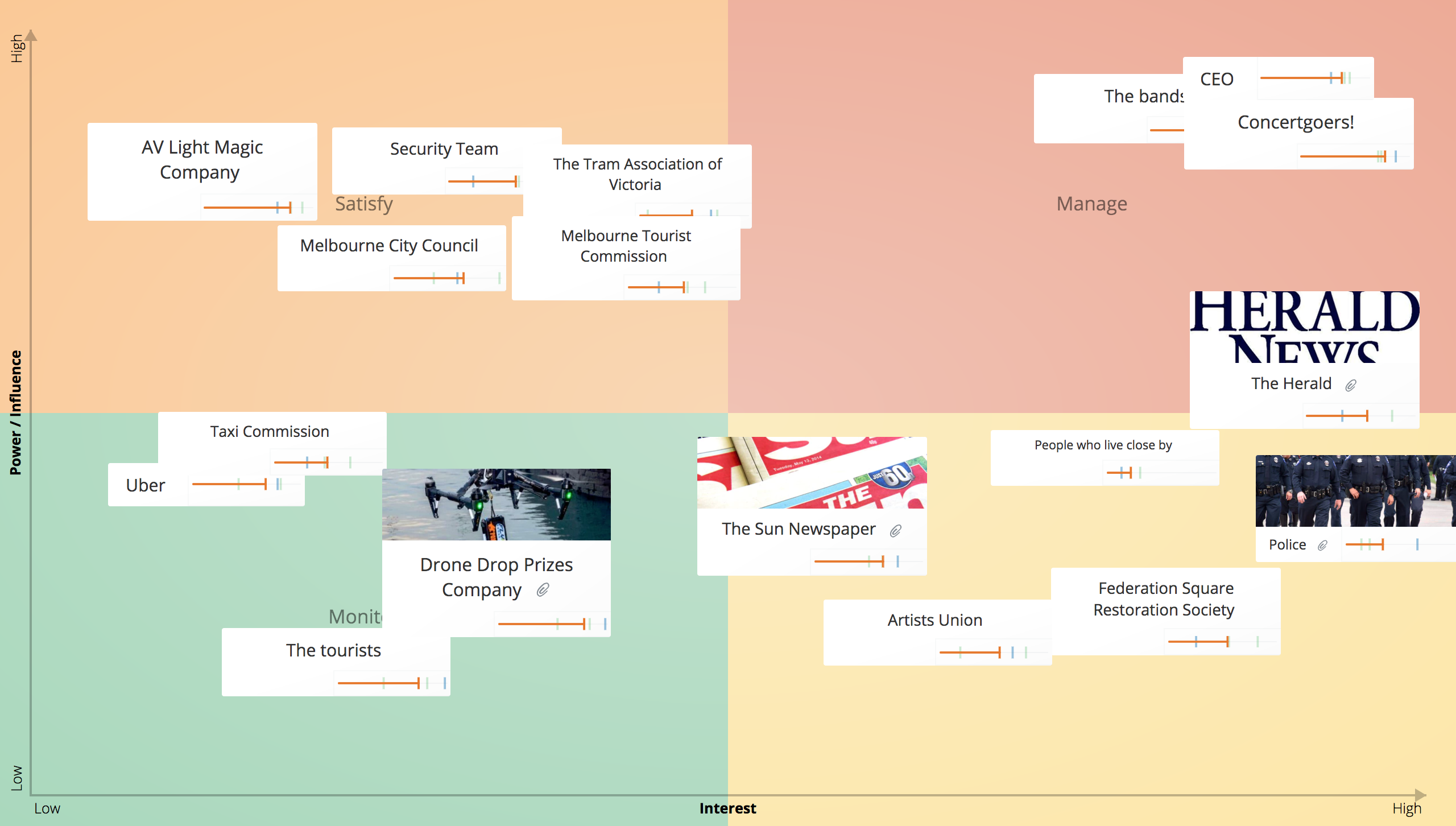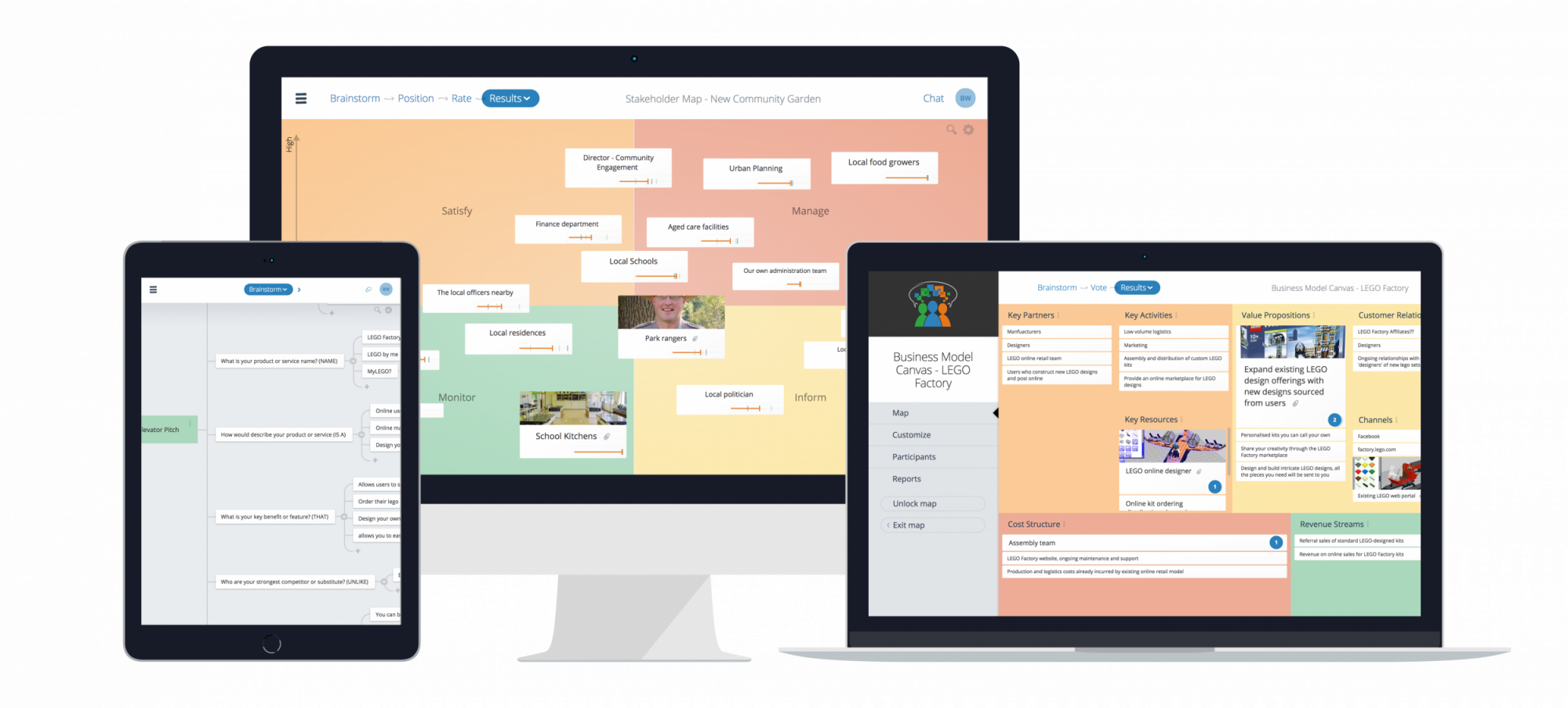
What is Stakeholder Analysis?
A simple but effective stakeholder analysis technique is stakeholder mapping. Interested parties (stakeholders) are plotted against two variables, most commonly Interest and Influence. The resulting stakeholder matrix clearly identifies key players who can have the greatest impact on the success of an initiative. This map assists with prioritization of resources and provides a foundation for a communications and engagement plan.
Stakeholder analysis can be done once at the beginning of a project or regularly throughout implementation to track changes in engagement.
Why Perform Stakeholder Analysis?
Understanding who your stakeholders are and the impact they may have on your business or project is crucial to success. Not engaging key players in the right way at an early stage can have disastrous results for a project.. The development of a stakeholder map:
- Creates a shared understanding of the key people who can impact on your success.
- Provides a foundation for your communications and engagement strategy.
- Identifies potential risks from negative stakeholders or those who feel they are not being heard.
- Prioritizes stakeholders so the appropriate amount of resources can be assigned and the right engagement strategy is applied.
Who Can Use Stakeholder Analysis?
Stakeholder management is critical to the success of every organization, program, and project. Stakeholder analysis is useful for:
- All industries
- All levels of an organization
- All departments
- Existing businesses
- New businesses
- Projects
- Business processes
Use stakeholder mapping:
- In regular organizational reviews
- When assessing changing business conditions
- When developing new initiatives
- As part of a broad environmental scan for initial planning
The process is especially important in the early stages of development and for projects that:
- Impact on the community
- Span across multiple teams or organizations
- Cross cultural boundaries
- Have external investors
- Business Model Canvas
- PEST analysis
- PESTLE analysis
- STEEP analysis
- Risk assessment
- Carefully select participants to provide expert knowledge but also a fresh perspective.
- Use technology to involve critical people in different locations rather than miss their contribution.
- Be specific rather than broad when defining stakeholders.
- Provide adequate time in the session to position and rate stakeholders.
- Communicate outcomes and regularly update throughout the project.
Stakeholder Analysis Template
A stakeholder analysis template, (aka stakeholder map) provides a visual representation of the importance of your stakeholders. Common dimensions used for a stakeholder map are:
- Level of Interest – How much a stakeholder cares about the outcomes. Are they beneficiaries or will there be negative effects?
- Level of Influence – The degree in which a stakeholder can make or break the project. For example through funding, legislation, protests, etc.
Other dimensions may be more relevant for some organizations. For example, level of investment, level of positive/negative commitment, level of support (advocate or adversary), need for outcomes etc.
The resulting stakeholder matrix gives an indication of what kind of engagement strategy is useful for each group of stakeholders.
Satisfy
Consider their objectives and keep them satisfied to ensure they remain strong advocates. Getting them off side poses a risk.
Examples:
- Regulators (eg. EPA, FDA, Tax)
- Administrators (ie. with discretion over budgets)
Monitor
Monitor their activity from time to time to stay on top of their involvement. Their relevance may change over time. Communicate to keep them informed and encourage their interest.
Examples:
- Support/Complementary Services
Manage
They have a lot of influence and a strong interest in the outcomes. Manage these stakeholders well to build strong relationships and ensure you retain their support. Involve them in decisions and engage regularly.
Examples:
- Trade Unions
- Politicians and senior officials
- Investors
- Senior Management
- Project Sponsors
Inform
Anticipate their needs and keep these stakeholders informed to ensure their continued support. Consult on their area of interest and use their input to improve your chances of success.
Examples:
- End users of a program or product
- Members of the community
- Community Action groups
- Media outlets
How to Create a Stakeholder Map
Assemble a cross-functional group of people with a range of perspectives on the business, product, service, or project to create the stakeholder map. The quality of the outcomes is dependent on the insight of the participants, and a diverse group helps to identify key stakeholders from across the entire spectrum of the business.
There are six general steps for a stakeholder mapping workshop. The time required will vary on the organization, the size of the group, and the focus of the session. However, there is no reason why the map can’t be completed within an hour. A comprehensive communications plan in response to the map will require further effort.

Scope
Give context and identify the scope of the stakeholder analysis

Brainstorm
Gather a comprehensive list of stakeholders.

Position
Position stakeholders according to their influence and interest.

Rate
Rate each stakeholder based on their level of support – from adversary to advocate

Action Plan
Identify actions, assign responsibilities and timeframes

Share
Report on the outcomes and monitor as part of your communications strategy Scope
Give context and define the scope of the stakeholder analysis. Ensure all participants understand the purpose of the session and how the results will be used. Goals will depend on the industry, organization, stage of the project, and your current communication and engagement objectives. For example, will the session focus on current stakeholders or those potentially affected by a new initiative.
Present data and information that provides context for the development of the stakeholder map. Examples of information might include:
- Results from a Business Impact Assessment, Business Model Canvas, SWOT Analysis, PESTLE Analysis
- Industry trends and news
- Relevant rules and regulations
Define criteria for the axis in the Stakeholder Map template. These definitions may be quite different from one stakeholder analysis to another.
The first step in building a stakeholder map is to create a categorized list of the people or groups who are interested or affected by your work and its outcomes, or who have influence or power over what you do.
Stakeholders usually fall into two main categories. Those that contribute to the initiative and those that are affected by it. Some stakeholder may fit into both categories.
Examples of stakeholder groups include:
- Owners and investors
- Direct and indirect customers
- Employees and beneficiaries
- Suppliers, competitors, and industry associations.
- The community including residents and special interest group
- Government authorities and regulatory bodies
Questions to consider:
- Will the stakeholder be affected by this project?
- Can they influence the project?
- Do they control or have influence over any necessary resources?
- Do they have special skills or capabilities that you need?
- At what stage does this stakeholder have the most impact?
Gather ideas using a whiteboard, sticky notes, poster paper or an online collaboration tool such as GroupMap. Using an online tool greatly reduces the time and effort to collate and organize the information in subsequent steps.
Once you have a complete list of stakeholders, position them on the stakeholder map template to give a visual representation of their relevance in relation to one another.
The matrix shows how critical each one is to the project and identifies where to focus your efforts for an effective communications and engagement strategy
This process can be done individually or in small groups then combined, or as a facilitated group discussion. A tool like GroupMap provides an enormous saving in time and effort at this stage, especially if you choose the first option as the software automatically provides a group average.
This step will add a third dimension to your stakeholder map and provide even more information to focus your limited time and resource on.
Rate each stakeholder based on their level of support – from adversary to advocate. Advocates will be your cheerleaders and will help you achieve success. Adversaries will make things difficult, and you will need to work hard to bring them onboard and manage their objections.
Discuss and add comments to each stakeholder to inform further actions. It’s neither practical nor necessary to communicate with all stakeholders at all stages of the process. The more information you have, the easier it will be to prioritize and target your efforts.
Once the group is happy they have identified the key stakeholders, they should determine the necessary follow-up activities, along with the people, expertise, and budget required to make them happen.
For example, you may need to conduct interviews or forums with some of the key players to work out exactly what motivates them, what information they want from you, and how they would like to receive it before you develop your communications plan.
Compile a report on the results of the Stakeholder Mapping process. The report should contain the stakeholder rankings, any planned actions along with those responsible, and timeframes for implementation.
A stakeholder map is not static. It will evolve as a project progresses and when stakeholders make decisions or change their opinions.
Use the report to:
- Communicate outcomes with participants and relevant stakeholders to encourage buy-in and ownership of stakeholder management efforts.
- Monitor the status of actions, and resource allocations on a regular basis as they are likely to change over time.
- Provide a foundation for future stakeholder mapping sessions
- Contribute to other business development and planning processes
GroupMap automatically generates visually appealing reports in several formats for distribution, saving time and effort after the workshop.

Save effort, time and money with GroupMap
Whether you have your best minds together in the same room, or distributed around the world, GroupMap’s unique technology allows groups of up to 2000 to submit ideas independently at separate times, from different places, in different timezones. Prevent dominant personalities swaying the group, drowning out the opinions of others – GroupMap allows everyone to brainstorm independently then effortlessly combines that information to reveal the full spectrum of ideas. GroupMap templates keep the objective front and center throughout the session, keeping everyone on task. This ensures the activity identifies actionable issues rather than becoming just a discussion on ideas. GroupMap gives you all the group decision making tools you need to prioritize, decide and take action.
Create your first map and invite people in to start sharing their thoughts right NOW. Experience the power of GroupMap with our 14-day, no risk, FREE trial. You don’t even need to provide your credit card details to access to all of our features, including the entire suite of templates, for a full 14 days.